MaryAnn Bernal's Blog, page 68
January 28, 2017
5 facts you (probably) didn’t know about Nelson’s navy
History Extra
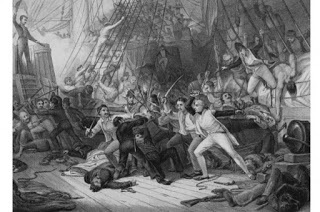
Commodore Horatio Nelson boarding the Spanish first rate ship of the line, the San Jose, at the Battle Cape St Vincent in 1797. (Photo by Hulton Archive/Getty Images)
1. Battle was not the main cause of death
It has been calculated that, during the wars with Revolutionary and Napoleonic France 1793-1815 – also known as the ‘Age of Sail’ – sailors were far more likely to die of disease or shipwreck than they ever were in fleet battle. Only 6.3 per cent of British sailors’ deaths in this period were caused by enemy action, rather than disease or accident (81.5 per cent) or shipwreck (12.2 per cent).
Fleet battle was not normal in relation to other British naval activity; most of the time the ships sat at anchor or patrolled windswept horizons in the constant toil of blockade. Life was dull. Sailors cleaned, painted and sewed. In terms of the day-to-day life of a sailor, which was lived in the cold, dark decks of a man of war, these years were very long indeed. Routine and discipline were therefore as important as cleanliness for the efficiency of any ship.
2. Sailors would rarely experience more than one battle
A sailor in the Royal Navy in 1805 would have served aboard one of 136 ships of the line - that is to say ships of 50 guns or more - or one of 160 cruisers; he would have been one of 114,012 sailors entered into British ships’ books. He could have been stationed in the North Sea, English Channel, Western Approaches, eastern or western Mediterranean, the Windward or Leeward Islands in the Caribbean, the East Indies or somewhere off the coast of North America.
Such a sailor would have been very lucky indeed to witness one battle, let alone more. Officers, especially talented ones, were more likely to witness fleet battle because they had a greater chance of being sent to trouble zones, and yet only three senior naval officers witnessed as many as three fleet battles in this period: Horatio Nelson, Cuthbert Collingwood and Edward Berry.
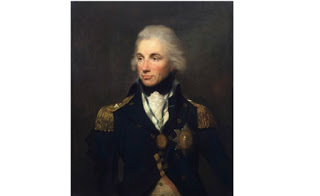
Portrait of Horatio Nelson by Lemuel Francis Abbott. Only three senior naval officers witnessed as many as three fleet battles in this period, one of which was Horatio Nelson. (Photo by VCG Wilson/Corbis via Getty Images)
3. Sailing warfare was chaos
In a naval battle in the ‘Age of Sail’, seascapes were shrouded by so much gun smoke that, in the midst of battle, visibility beyond a few feet was all but impossible. Confusion begat chaos, well-laid plans disintegrated, and random acts tipped battle one way or another.
This was the nature of sailing warfare. Incidents of friendly fire were common. Wind and swell, tide and current, light and dark, were all capable of ruining the best plans. The ships’ rigs were so vulnerable to damage that a single lucky shot could cripple any warship. The sudden death or injury of a ship’s officers could bring a crew to a standstill and the sudden death or injury of a large portion of the crew could bring the officers to standstill: neither could work without the other and both were vulnerable. As a rule, nothing ever went to plan.
4. The sails of a relatively small warship could block out two acres of sky A 74-gun, two-decked warship, the spine of the line of battle, contained a crew of more than 600 men and 1,200 tons of food. Cows, pigs, goats, sheep and fowl of numerous types berthed alongside the men. The ship would have been propelled by sails that blocked out two acres of sky, and those sails were worked by 25 miles of rigging. Her 74 guns produced more firepower than Napoleon’s artillery at the 1805 battle of Austerlitz. And that was just one relatively small ship. Some of the largest contained crews of 1,200 men or more and displaced at least 3,000 tons − that is roughly twice as much as a standard 74-gunner of the 1790s.
Now consider a fleet of warships. At Trafalgar in 1805 we know that the British fleet consisted of approximately 17,000 men in 27 ships mounting 2,148 cannon. The combined Franco-Spanish fleet was larger still, with some 30,000 men in 33 ships mounting 2,632 guns.
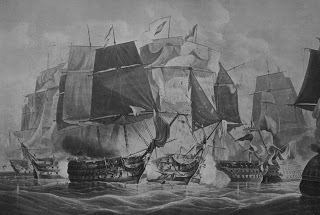
At the battle of Trafalgar in 1805, a major naval battle between the British Navy and the combined fleets of France and Spain, the British fleet consisted of approximately 17,000 men in 27 ships. (Photo by Print Collector/Getty Images)
5. Not every officer would do his duty
The most famous naval signal was that flown before the battle of Trafalgar by Horatio Nelson: “England expects that every man will do his duty”. Yet British naval history – including the battle of Trafalgar – is full of examples of captains and fleet officers not doing their duty.
Captain Anthony Molloy was court martialled after the battle of the Glorious First of June in 1794 for 'failing to do his utmost to engage the enemy' and was never employed again. Vice Admiral Bridport was strongly criticised within the navy for his failure to press his victory at the battle of Groix a year later, even if the public saw him as a hero for capturing three ships in that battle and for a career of sustained success.
Jervis was furious with the conduct of Admiral Sir Charles Thompson at the battle of St Vincent, and Captain John Williamson was dismissed after the battle of Camperdown for failing to bring his ship into action. Nelson was deeply unimpressed with the behaviour of Captain Davidge Gould at the Nile for failing to use his initiative and support his fellow captains as ordered in a battle which, more than any other, is so heavily linked with the idea of a ‘band of brothers’.
Admiral Hyde Parker was blacklisted by the Admiralty and never employed again after the battle of Copenhagen, while Captain Edward Berry blazed away ineffectively at both Trafalgar and San Domingo and was quickly retired from the active list. At Trafalgar, several officers, including Nelson’s third in command, Rear Admiral the Earl of Northesk, performed, according to the words of Edward Rotherham, Vice-Admiral Cuthbert Collingwood's flag captain ‘notoriously ill’; and Vice Admiral John Duckworth never received the hereditary peerage he expected after the Battle of San Domingo.
Dr Sam Willis is a historian, archaeologist and broadcaster and one of the world's leading authorities on maritime and naval history.

Commodore Horatio Nelson boarding the Spanish first rate ship of the line, the San Jose, at the Battle Cape St Vincent in 1797. (Photo by Hulton Archive/Getty Images)
1. Battle was not the main cause of death
It has been calculated that, during the wars with Revolutionary and Napoleonic France 1793-1815 – also known as the ‘Age of Sail’ – sailors were far more likely to die of disease or shipwreck than they ever were in fleet battle. Only 6.3 per cent of British sailors’ deaths in this period were caused by enemy action, rather than disease or accident (81.5 per cent) or shipwreck (12.2 per cent).
Fleet battle was not normal in relation to other British naval activity; most of the time the ships sat at anchor or patrolled windswept horizons in the constant toil of blockade. Life was dull. Sailors cleaned, painted and sewed. In terms of the day-to-day life of a sailor, which was lived in the cold, dark decks of a man of war, these years were very long indeed. Routine and discipline were therefore as important as cleanliness for the efficiency of any ship.
2. Sailors would rarely experience more than one battle
A sailor in the Royal Navy in 1805 would have served aboard one of 136 ships of the line - that is to say ships of 50 guns or more - or one of 160 cruisers; he would have been one of 114,012 sailors entered into British ships’ books. He could have been stationed in the North Sea, English Channel, Western Approaches, eastern or western Mediterranean, the Windward or Leeward Islands in the Caribbean, the East Indies or somewhere off the coast of North America.
Such a sailor would have been very lucky indeed to witness one battle, let alone more. Officers, especially talented ones, were more likely to witness fleet battle because they had a greater chance of being sent to trouble zones, and yet only three senior naval officers witnessed as many as three fleet battles in this period: Horatio Nelson, Cuthbert Collingwood and Edward Berry.

Portrait of Horatio Nelson by Lemuel Francis Abbott. Only three senior naval officers witnessed as many as three fleet battles in this period, one of which was Horatio Nelson. (Photo by VCG Wilson/Corbis via Getty Images)
3. Sailing warfare was chaos
In a naval battle in the ‘Age of Sail’, seascapes were shrouded by so much gun smoke that, in the midst of battle, visibility beyond a few feet was all but impossible. Confusion begat chaos, well-laid plans disintegrated, and random acts tipped battle one way or another.
This was the nature of sailing warfare. Incidents of friendly fire were common. Wind and swell, tide and current, light and dark, were all capable of ruining the best plans. The ships’ rigs were so vulnerable to damage that a single lucky shot could cripple any warship. The sudden death or injury of a ship’s officers could bring a crew to a standstill and the sudden death or injury of a large portion of the crew could bring the officers to standstill: neither could work without the other and both were vulnerable. As a rule, nothing ever went to plan.
4. The sails of a relatively small warship could block out two acres of sky A 74-gun, two-decked warship, the spine of the line of battle, contained a crew of more than 600 men and 1,200 tons of food. Cows, pigs, goats, sheep and fowl of numerous types berthed alongside the men. The ship would have been propelled by sails that blocked out two acres of sky, and those sails were worked by 25 miles of rigging. Her 74 guns produced more firepower than Napoleon’s artillery at the 1805 battle of Austerlitz. And that was just one relatively small ship. Some of the largest contained crews of 1,200 men or more and displaced at least 3,000 tons − that is roughly twice as much as a standard 74-gunner of the 1790s.
Now consider a fleet of warships. At Trafalgar in 1805 we know that the British fleet consisted of approximately 17,000 men in 27 ships mounting 2,148 cannon. The combined Franco-Spanish fleet was larger still, with some 30,000 men in 33 ships mounting 2,632 guns.

At the battle of Trafalgar in 1805, a major naval battle between the British Navy and the combined fleets of France and Spain, the British fleet consisted of approximately 17,000 men in 27 ships. (Photo by Print Collector/Getty Images)
5. Not every officer would do his duty
The most famous naval signal was that flown before the battle of Trafalgar by Horatio Nelson: “England expects that every man will do his duty”. Yet British naval history – including the battle of Trafalgar – is full of examples of captains and fleet officers not doing their duty.
Captain Anthony Molloy was court martialled after the battle of the Glorious First of June in 1794 for 'failing to do his utmost to engage the enemy' and was never employed again. Vice Admiral Bridport was strongly criticised within the navy for his failure to press his victory at the battle of Groix a year later, even if the public saw him as a hero for capturing three ships in that battle and for a career of sustained success.
Jervis was furious with the conduct of Admiral Sir Charles Thompson at the battle of St Vincent, and Captain John Williamson was dismissed after the battle of Camperdown for failing to bring his ship into action. Nelson was deeply unimpressed with the behaviour of Captain Davidge Gould at the Nile for failing to use his initiative and support his fellow captains as ordered in a battle which, more than any other, is so heavily linked with the idea of a ‘band of brothers’.
Admiral Hyde Parker was blacklisted by the Admiralty and never employed again after the battle of Copenhagen, while Captain Edward Berry blazed away ineffectively at both Trafalgar and San Domingo and was quickly retired from the active list. At Trafalgar, several officers, including Nelson’s third in command, Rear Admiral the Earl of Northesk, performed, according to the words of Edward Rotherham, Vice-Admiral Cuthbert Collingwood's flag captain ‘notoriously ill’; and Vice Admiral John Duckworth never received the hereditary peerage he expected after the Battle of San Domingo.
Dr Sam Willis is a historian, archaeologist and broadcaster and one of the world's leading authorities on maritime and naval history.
Published on January 28, 2017 01:30
January 27, 2017
King Richard III Feasted on Wine and Swans
Seeker

BY ROSSELLA LORENZI
In the last three years of his life, King Richard III consumed up to three liters of alcohol per day and feasted on swan, egret and heron, analysis of the monarch’s teeth and bones has revealed.
Researchers from the British Geological Survey and the University of Leicester examined changes in chemistry in the bones of the last Plantagenet king, whose remains were found buried beneath a parking lot in the English city of Leicester in 2012.
“We applied multi-element isotope techniques to reconstruct a full life history,” Angela Lamb, isotope geochemist at the British Geological Survey, Richard Buckley from the University of Leicester Archaeological Services, and colleagues wrote in the latest issue of the Journal of Archaeological Science.
Born in Northamptonshire in 1452, Richard became King of England in 1483 at the age of 30, ruling for just two years and two months.
The king, depicted by William Shakespeare as a bloodthirsty usurper, was killed in 1485 in the Battle of Bosworth, which was the last act of the decades-long fight over the throne known as War of the Roses. He was defeated by Henry Tudor, who became King Henry VII.
The researchers measured the levels of certain chemicals, such as strontium, nitrogen, oxygen, carbon and lead that relate to geographical location, pollution and diet in three locations on the skeleton of Richard III.
They analyzed bioapatite and collagen from sections of two teeth, which formed during childhood and early adolescence, and from two bones: the femur, which represents an average of the 15 years before death, and the rib, which remodels faster and represents between 2 and 5 years of life before death.
“The isotopes initially concur with Richard’s known origins in Northamptonshire, but suggest that he had moved out of eastern England by age seven, and resided further west, possibly the Welsh Marches,” the researchers wrote.
The isotope changes became evident between Richard’s femur and rib bones, revealing “a significant shift” in the nitrogen isotope values towards the end of Richard life, coinciding directly with his time as King of England.
The shift would correspond to an increase in consumption of luxury items such as game birds (swans, herons, egret) and freshwater fish.
“The Late Medieval diet of an aristocrat consisted of bread, ale, meat, fish, wine and spices with a strong correlation between wealth and the relative proportions of these, with more wine and spices and proportionally less ale and cereals with increasing wealth,” the researchers said.
Another significant shift was recorded in Richard’s oxygen isotope values, which also rose towards the end of his life.
“As we know he did not relocate during this time, we suggest the changes could be brought about by increased wine consumption,” Lamb and colleagues wrote.
The analysis showed there was a 25 percent increase in Richard’s consumption of wine when he became king.
This would equal to a bottle of wine per day, in addition to the large quantities of beer most medieval men consumed at that time, giving Richard an overall alcohol consumption of two to three liters per day.
Indeed, Richard began to indulge in food and wine since his coronation banquet, noted for being particularly long and elaborate. The excesses are likely to have continued throughout his short lived reign.
“It is not unexpected that his consumption of wine and rich foods increased over the last few years of his life,” the researchers wrote.
Richard III will be finally reburied in Leicester Cathedral on March 26, 2015 at the end of a seven-day program of events in Leicester and Leicestershire to honor the king.
Image: Late 16th century portrait of Richard III, housed in the National Portrait Gallery, London. Credt: Wikimedia Commons.

BY ROSSELLA LORENZI
In the last three years of his life, King Richard III consumed up to three liters of alcohol per day and feasted on swan, egret and heron, analysis of the monarch’s teeth and bones has revealed.
Researchers from the British Geological Survey and the University of Leicester examined changes in chemistry in the bones of the last Plantagenet king, whose remains were found buried beneath a parking lot in the English city of Leicester in 2012.
“We applied multi-element isotope techniques to reconstruct a full life history,” Angela Lamb, isotope geochemist at the British Geological Survey, Richard Buckley from the University of Leicester Archaeological Services, and colleagues wrote in the latest issue of the Journal of Archaeological Science.
Born in Northamptonshire in 1452, Richard became King of England in 1483 at the age of 30, ruling for just two years and two months.
The king, depicted by William Shakespeare as a bloodthirsty usurper, was killed in 1485 in the Battle of Bosworth, which was the last act of the decades-long fight over the throne known as War of the Roses. He was defeated by Henry Tudor, who became King Henry VII.
The researchers measured the levels of certain chemicals, such as strontium, nitrogen, oxygen, carbon and lead that relate to geographical location, pollution and diet in three locations on the skeleton of Richard III.
They analyzed bioapatite and collagen from sections of two teeth, which formed during childhood and early adolescence, and from two bones: the femur, which represents an average of the 15 years before death, and the rib, which remodels faster and represents between 2 and 5 years of life before death.
“The isotopes initially concur with Richard’s known origins in Northamptonshire, but suggest that he had moved out of eastern England by age seven, and resided further west, possibly the Welsh Marches,” the researchers wrote.
The isotope changes became evident between Richard’s femur and rib bones, revealing “a significant shift” in the nitrogen isotope values towards the end of Richard life, coinciding directly with his time as King of England.
The shift would correspond to an increase in consumption of luxury items such as game birds (swans, herons, egret) and freshwater fish.
“The Late Medieval diet of an aristocrat consisted of bread, ale, meat, fish, wine and spices with a strong correlation between wealth and the relative proportions of these, with more wine and spices and proportionally less ale and cereals with increasing wealth,” the researchers said.
Another significant shift was recorded in Richard’s oxygen isotope values, which also rose towards the end of his life.
“As we know he did not relocate during this time, we suggest the changes could be brought about by increased wine consumption,” Lamb and colleagues wrote.
The analysis showed there was a 25 percent increase in Richard’s consumption of wine when he became king.
This would equal to a bottle of wine per day, in addition to the large quantities of beer most medieval men consumed at that time, giving Richard an overall alcohol consumption of two to three liters per day.
Indeed, Richard began to indulge in food and wine since his coronation banquet, noted for being particularly long and elaborate. The excesses are likely to have continued throughout his short lived reign.
“It is not unexpected that his consumption of wine and rich foods increased over the last few years of his life,” the researchers wrote.
Richard III will be finally reburied in Leicester Cathedral on March 26, 2015 at the end of a seven-day program of events in Leicester and Leicestershire to honor the king.
Image: Late 16th century portrait of Richard III, housed in the National Portrait Gallery, London. Credt: Wikimedia Commons.
Published on January 27, 2017 02:00
Q&A: When were the first film trailers shown?
History Extra

A poster for Charlie Chaplin's 1921 comedy 'The Kid’. Several Charlie Chaplin comedies were among the first films to use a trailer. (Photo by Movie Poster Image Art/Getty Images)
One of the first film trailers appeared in New York in 1913 and was the brainchild of Nils Granlund, an innovative marketing manager for the Marcus Loew chain of movie theatres who went on to become famous as a pioneer broadcaster on radio – and notorious as the producer of risqué Broadway revues. Granlund’s first trailer was for a stage show but he went on to create others for upcoming films, including several Charlie Chaplin comedies.
His idea was seized upon by other moviemakers and cinema owners and soon no film was complete without its trailer. The short films came to be known as trailers because the projectionists originally tended to add them to the end of the reels of the B-movie in a show. Thus they trailed after the supporting movie but came before the main feature.
Answered by: Nick Rennison

A poster for Charlie Chaplin's 1921 comedy 'The Kid’. Several Charlie Chaplin comedies were among the first films to use a trailer. (Photo by Movie Poster Image Art/Getty Images)
One of the first film trailers appeared in New York in 1913 and was the brainchild of Nils Granlund, an innovative marketing manager for the Marcus Loew chain of movie theatres who went on to become famous as a pioneer broadcaster on radio – and notorious as the producer of risqué Broadway revues. Granlund’s first trailer was for a stage show but he went on to create others for upcoming films, including several Charlie Chaplin comedies.
His idea was seized upon by other moviemakers and cinema owners and soon no film was complete without its trailer. The short films came to be known as trailers because the projectionists originally tended to add them to the end of the reels of the B-movie in a show. Thus they trailed after the supporting movie but came before the main feature.
Answered by: Nick Rennison
Published on January 27, 2017 00:16
January 26, 2017
8 surprising facts about Tutankhamun
History Extra
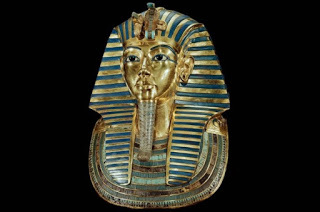
Golden funeral mask of Tutankhamun. Egyptian National Museum, Cairo. (Photo by Leemage/Corbis via Getty Images)
1) His original name was not Tutankhamun
Tutankhamun was originally named Tutankhaten. This name, which literally means “living image of the Aten”, reflected the fact that Tutankhaten’s parents worshipped a sun god known as “the Aten”. After a few years on the throne the young king changed his religion, abandoned the Aten, and started to worship the god Amun [who was revered as king of the gods]. This caused him to change his name to Tutankhamun, or “living image of Amun”.
Tutankhamun was not, however, the name by which his people knew him. Like all of Egypt’s kings, Tutankhamun actually had five royal names. These took the form of short sentences that outlined the focus of his reign. Officially, he was:
(1) Horus Name: Image of births
(2) Two Ladies Name: Beautiful of laws who quells the Two Lands/who makes content all the gods (3) Golden Horus Name: Elevated of appearances for the god/his father Re
(4) Prenomen: Nebkheperure
(5) Nomen: Tutankhamun
His last two names, known today as the prenomen and the nomen, are the names that we see written in cartouches (oval loops) on his monuments. We know him by his nomen, Tutankhamun. His people, however, knew him by his prenomen, Nebkheperure, which literally translates as “[the sun god] Re is the lord of manifestations”.
2) Tutankhamun has the smallest royal tomb in the Valley of the Kings
The first pharaohs built highly conspicuous pyramids in Egypt’s northern deserts. However, by the time of the New Kingdom (1550–1069 BC), this fashion had ended. Most kings were now buried in relative secrecy in rock-cut tombs tunnelled into the Valley of the Kings on the west bank of the Nile at the southern city of Thebes (modern-day Luxor). These tombs had inconspicuous doors, but were both spacious and well decorated inside.
Cemeteries carried their own potent magic, and dead kings were thought to have powerful spirits that might benefit others. Burial amongst his ancestors would have helped Tutankhamun to achieve his own afterlife. It therefore seems likely that Tutankhamun would have wished to be buried in a splendid tomb in either the main valley or in an offshoot, the Western Valley, where his grandfather, Amenhotep III, was buried. But, whatever he may have had intended, we know that Tutankhamun was actually buried in a cramped tomb cut into the floor of the main valley.
It may be that Tutankhamun simply died too young to complete his ambitious plans. His own tomb was unfinished, and so he had to be buried in a substitute, non-royal tomb. However, this seems unlikely, as other kings managed to build suitable tombs in just two or three years. It seems far more likely that Tutankhamun’s successor, Ay, a king who inherited the throne as an elderly man, made a strategic swap. Just four years after Tutankhamun’s death, Ay himself was buried in a splendid tomb in the Western Valley, close by the tomb of Amenhotep III.
The unexpectedly small size of Tutankhamun’s tomb has led to recent suggestions that there may be parts as yet undiscovered. Currently Egyptologists are investigating the possibility that there may be secret chambers hidden behind the plastered wall of his burial chamber.
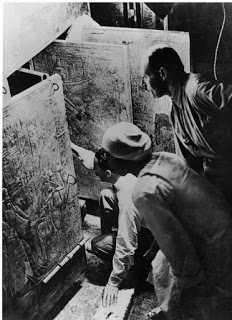
British archaeologist and Egyptologist Howard Carter (left) and his assistant Arthur Callender opening the entrance to Tutankhamun's tomb, 1922. (Photo by Hulton Archive/Getty Images)
3) He was buried in a second-hand coffin
Tutankhamun’s mummy lay within a nest of three golden coffins, which fitted snugly one inside another like a set of Russian dolls. During the funeral ritual the combined coffins were placed in a rectangular stone sarcophagus. Unfortunately, the outer coffin proved to be slightly too big, and its toes peeked over the edge of the sarcophagus, preventing the lid from closing. Carpenters were quickly summoned and the coffin’s toes were cut away. More than 3,000 years later Howard Carter would find the fragments lying in the base of the sarcophagus.
All three of Tutankhamun’s coffins were similar in style: they were “anthropoid”, or human-form coffins, shaped to look like the god of the dead, Osiris, lying on his back and holding the crook and flail in his crossed arms. But the middle coffin had a slightly different style and its face did not look like the faces on other two coffins. Nor did it look like the face on Tutankhamun’s death mask. Many Egyptologists now believe that this middle coffin – along with some of Tutankhamun’s other grave goods – was originally made for the mysterious “Neferneferuaten” – an enigmatic individual whose name is recorded in inscriptions and who may have been Tutankhamun’s immediate predecessor. We do not know what happened to Neferneferuaten, nor how Tutankhamun came to be buried in his or her coffin.
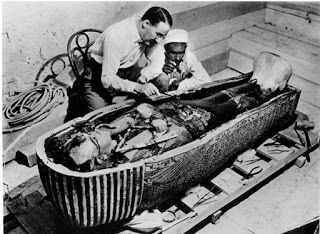
Howard Carter removing oils from the coffin of Tutankhamun, 1922. (Photo by Mansell/Mansell/The LIFE Picture Collection/Getty Images)
4) Tutankhamun loved to hunt ostriches
Tutankhamun’s ostrich-feather fan was discovered lying in his burial chamber, close by the king’s body. Originally the fan consisted of a long golden handle topped by a semi-circular ‘palm’ that supported 42 alternating brown and white feathers. These feathers crumbled away long ago, but their story is preserved in writing on the fan handle. This tells us that that the feathers were taken from ostriches captured by the king himself while hunting in the desert to the east of Heliopolis (near modern-day Cairo). The embossed scene on the palm shows, on one face, Tutankhamun setting off in his chariot to hunt ostrich, and on the reverse, the king returning in triumph with his prey.
Ostriches were important birds in ancient Egypt, and their feathers and eggs were prized as luxury items. Hunting ostriches was a royal sport that allowed the king to demonstrate his control over nature. It was a substitute for battle and, as such, was a dangerous occupation. We can see that Tutankhamun’s body was badly damaged before he was mummified. Is the placement of his ostrich fan so close to his body significant? Is this, perhaps, someone’s way of telling us that the young king died following a fatal accident on an ostrich hunt?
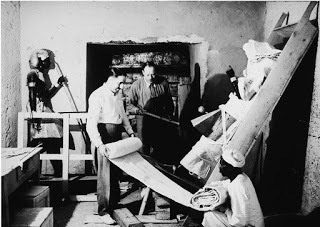
Howard Carter (left) and Arthur Callender systematically remove objects from the antechamber of the tomb of Tutankhamun with the assistance of an Egyptian labourer. (Photo by Hulton Archive/Getty Images)
5) His heart is missing
The ancient Egyptians believed that it was possible to live again after death, but thought that this could only be achieved if the body was preserved in a lifelike condition. This led them to develop the science of artificial mummification.
Essentially, mummification involved desiccating the body in natron salt, then wrapping it in many layers of bandages to preserve a lifelike shape. The body’s internal organs were removed at the start of the mummification process and preserved separately. The brain, its function then unknown, was simply thrown away – the heart, rather than the brain, was regarded as the organ of reasoning. As such, the heart would be required in the afterlife. It was therefore left in place and, if accidentally removed, immediately sewn back; though not always in its original location.
Tutankhamun, however, has no heart. Instead he was provided with an amuletic scarab inscribed with a funerary spell. This may have happened simply because the undertakers were careless, but it could also be a sign that Tutankhamun died far from home. By the time his body arrived at the undertakers’ workshop, his heart may have been too decayed to be preserved.
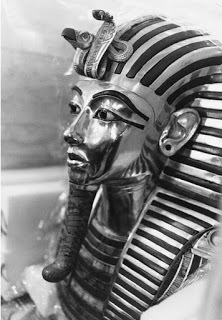
The mask of Tutankhamun, seen at the British Museum, London, January 1972. (Photo by Kean Collection/Getty Images)
6) One of Tutankhamun’s favourite possessions was an iron dagger Howard Carter discovered two daggers carefully wrapped inside Tutankhamun’s mummy bandages. One dagger had a gold blade, while the other had a blade made of iron. Each dagger had a gold sheath. Of the two, the iron dagger was by far the more valuable because, during Tutankhamun’s lifetime (he reigned from c1336–27 BC), iron, or “iron from the sky” as it was known, was a rare and precious metal. As its name suggests, Egypt’s “iron from the sky” was almost entirely obtained from meteorites.
Several other iron objects were found in Tutankhamun’s tomb: 16 miniature blades, a tiny headrest and an amulet. The fact that these pieces are not particularly well made, combined with their small size, suggest that they were made by local craftsmen who struggled to work the rare meteorite iron. The dagger blade, however, is very different. Beautifully crafted, it is likely to have been imported to Egypt from a region accustomed to working iron. The royal diplomatic archives tell us that, several years before Tutankhamun’s birth, king Tushratta of Mitanni sent a metal dagger to Egypt as a gift to his new son-in-law, Amenhotep III. Given the rarity of good quality iron artefacts at this time, it is possible that Amenhotep’s dagger was inherited by his grandson, Tutankhamun, and eventually buried with him. Given its prominent location within the mummy bandages, it may even be that Tushratta’s dagger was used in Tutankhamun’s mummification ritual.
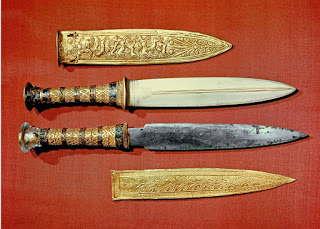
Tutankhamun’s daggers, one with a blade of gold, the other of iron. (Robert Harding/Alamy Stock Photo)
7) His trumpets have entertained an audience of more than 150 million Tutankhamun’s grave goods included a small collection of musical instruments: one pair of ivory clappers, two sistra (rattles) and two trumpets, one made from silver with a gold mouthpiece and the other made of bronze partially overlaid by gold. This would not have made a very satisfactory orchestra, and it seems that music was not high on Tutankhamun’s list of priorities for his afterlife. In fact, his trumpets should more properly be classified as military equipment, while his clappers and sistra are likely to have had a ritual purpose.
On 16 April 1939, the two trumpets were played in a BBC live radio broadcast from Cairo Museum, which reached an estimated 150 million listeners. Bandsman James Tappern used a modern mouthpiece, which caused damage to the silver trumpet. In 1941 the bronze trumpet was played again, this time without a modern mouthpiece.
Some, influenced by the myth of “Tutankhamun’s curse”, have claimed that the trumpets have the power to summon war. They have suggested that it was the 1939 broadcast which caused Britain to enter the Second World War.
8) Tutankhamun was buried in the world’s most expensive coffin
Two of Tutankhamun’s three coffins were made of wood, covered with gold sheet. But, to Howard Carter’s great surprise, the innermost coffin was made from thick sheets of beaten gold. This coffin measures 1.88m in length, and weighs 110.4kg. If it were to be scrapped today it would be worth well over £1m. But as Tutankhamun’s final resting place it is, of course, priceless.
Joyce Tyldesley teaches a suite of online courses in Egyptology at the University of Manchester. She is the author of Tutankhamen’s Curse: the Developing History of an Egyptian King (Profile 2012).

Golden funeral mask of Tutankhamun. Egyptian National Museum, Cairo. (Photo by Leemage/Corbis via Getty Images)
1) His original name was not Tutankhamun
Tutankhamun was originally named Tutankhaten. This name, which literally means “living image of the Aten”, reflected the fact that Tutankhaten’s parents worshipped a sun god known as “the Aten”. After a few years on the throne the young king changed his religion, abandoned the Aten, and started to worship the god Amun [who was revered as king of the gods]. This caused him to change his name to Tutankhamun, or “living image of Amun”.
Tutankhamun was not, however, the name by which his people knew him. Like all of Egypt’s kings, Tutankhamun actually had five royal names. These took the form of short sentences that outlined the focus of his reign. Officially, he was:
(1) Horus Name: Image of births
(2) Two Ladies Name: Beautiful of laws who quells the Two Lands/who makes content all the gods (3) Golden Horus Name: Elevated of appearances for the god/his father Re
(4) Prenomen: Nebkheperure
(5) Nomen: Tutankhamun
His last two names, known today as the prenomen and the nomen, are the names that we see written in cartouches (oval loops) on his monuments. We know him by his nomen, Tutankhamun. His people, however, knew him by his prenomen, Nebkheperure, which literally translates as “[the sun god] Re is the lord of manifestations”.
2) Tutankhamun has the smallest royal tomb in the Valley of the Kings
The first pharaohs built highly conspicuous pyramids in Egypt’s northern deserts. However, by the time of the New Kingdom (1550–1069 BC), this fashion had ended. Most kings were now buried in relative secrecy in rock-cut tombs tunnelled into the Valley of the Kings on the west bank of the Nile at the southern city of Thebes (modern-day Luxor). These tombs had inconspicuous doors, but were both spacious and well decorated inside.
Cemeteries carried their own potent magic, and dead kings were thought to have powerful spirits that might benefit others. Burial amongst his ancestors would have helped Tutankhamun to achieve his own afterlife. It therefore seems likely that Tutankhamun would have wished to be buried in a splendid tomb in either the main valley or in an offshoot, the Western Valley, where his grandfather, Amenhotep III, was buried. But, whatever he may have had intended, we know that Tutankhamun was actually buried in a cramped tomb cut into the floor of the main valley.
It may be that Tutankhamun simply died too young to complete his ambitious plans. His own tomb was unfinished, and so he had to be buried in a substitute, non-royal tomb. However, this seems unlikely, as other kings managed to build suitable tombs in just two or three years. It seems far more likely that Tutankhamun’s successor, Ay, a king who inherited the throne as an elderly man, made a strategic swap. Just four years after Tutankhamun’s death, Ay himself was buried in a splendid tomb in the Western Valley, close by the tomb of Amenhotep III.
The unexpectedly small size of Tutankhamun’s tomb has led to recent suggestions that there may be parts as yet undiscovered. Currently Egyptologists are investigating the possibility that there may be secret chambers hidden behind the plastered wall of his burial chamber.

British archaeologist and Egyptologist Howard Carter (left) and his assistant Arthur Callender opening the entrance to Tutankhamun's tomb, 1922. (Photo by Hulton Archive/Getty Images)
3) He was buried in a second-hand coffin
Tutankhamun’s mummy lay within a nest of three golden coffins, which fitted snugly one inside another like a set of Russian dolls. During the funeral ritual the combined coffins were placed in a rectangular stone sarcophagus. Unfortunately, the outer coffin proved to be slightly too big, and its toes peeked over the edge of the sarcophagus, preventing the lid from closing. Carpenters were quickly summoned and the coffin’s toes were cut away. More than 3,000 years later Howard Carter would find the fragments lying in the base of the sarcophagus.
All three of Tutankhamun’s coffins were similar in style: they were “anthropoid”, or human-form coffins, shaped to look like the god of the dead, Osiris, lying on his back and holding the crook and flail in his crossed arms. But the middle coffin had a slightly different style and its face did not look like the faces on other two coffins. Nor did it look like the face on Tutankhamun’s death mask. Many Egyptologists now believe that this middle coffin – along with some of Tutankhamun’s other grave goods – was originally made for the mysterious “Neferneferuaten” – an enigmatic individual whose name is recorded in inscriptions and who may have been Tutankhamun’s immediate predecessor. We do not know what happened to Neferneferuaten, nor how Tutankhamun came to be buried in his or her coffin.

Howard Carter removing oils from the coffin of Tutankhamun, 1922. (Photo by Mansell/Mansell/The LIFE Picture Collection/Getty Images)
4) Tutankhamun loved to hunt ostriches
Tutankhamun’s ostrich-feather fan was discovered lying in his burial chamber, close by the king’s body. Originally the fan consisted of a long golden handle topped by a semi-circular ‘palm’ that supported 42 alternating brown and white feathers. These feathers crumbled away long ago, but their story is preserved in writing on the fan handle. This tells us that that the feathers were taken from ostriches captured by the king himself while hunting in the desert to the east of Heliopolis (near modern-day Cairo). The embossed scene on the palm shows, on one face, Tutankhamun setting off in his chariot to hunt ostrich, and on the reverse, the king returning in triumph with his prey.
Ostriches were important birds in ancient Egypt, and their feathers and eggs were prized as luxury items. Hunting ostriches was a royal sport that allowed the king to demonstrate his control over nature. It was a substitute for battle and, as such, was a dangerous occupation. We can see that Tutankhamun’s body was badly damaged before he was mummified. Is the placement of his ostrich fan so close to his body significant? Is this, perhaps, someone’s way of telling us that the young king died following a fatal accident on an ostrich hunt?

Howard Carter (left) and Arthur Callender systematically remove objects from the antechamber of the tomb of Tutankhamun with the assistance of an Egyptian labourer. (Photo by Hulton Archive/Getty Images)
5) His heart is missing
The ancient Egyptians believed that it was possible to live again after death, but thought that this could only be achieved if the body was preserved in a lifelike condition. This led them to develop the science of artificial mummification.
Essentially, mummification involved desiccating the body in natron salt, then wrapping it in many layers of bandages to preserve a lifelike shape. The body’s internal organs were removed at the start of the mummification process and preserved separately. The brain, its function then unknown, was simply thrown away – the heart, rather than the brain, was regarded as the organ of reasoning. As such, the heart would be required in the afterlife. It was therefore left in place and, if accidentally removed, immediately sewn back; though not always in its original location.
Tutankhamun, however, has no heart. Instead he was provided with an amuletic scarab inscribed with a funerary spell. This may have happened simply because the undertakers were careless, but it could also be a sign that Tutankhamun died far from home. By the time his body arrived at the undertakers’ workshop, his heart may have been too decayed to be preserved.

The mask of Tutankhamun, seen at the British Museum, London, January 1972. (Photo by Kean Collection/Getty Images)
6) One of Tutankhamun’s favourite possessions was an iron dagger Howard Carter discovered two daggers carefully wrapped inside Tutankhamun’s mummy bandages. One dagger had a gold blade, while the other had a blade made of iron. Each dagger had a gold sheath. Of the two, the iron dagger was by far the more valuable because, during Tutankhamun’s lifetime (he reigned from c1336–27 BC), iron, or “iron from the sky” as it was known, was a rare and precious metal. As its name suggests, Egypt’s “iron from the sky” was almost entirely obtained from meteorites.
Several other iron objects were found in Tutankhamun’s tomb: 16 miniature blades, a tiny headrest and an amulet. The fact that these pieces are not particularly well made, combined with their small size, suggest that they were made by local craftsmen who struggled to work the rare meteorite iron. The dagger blade, however, is very different. Beautifully crafted, it is likely to have been imported to Egypt from a region accustomed to working iron. The royal diplomatic archives tell us that, several years before Tutankhamun’s birth, king Tushratta of Mitanni sent a metal dagger to Egypt as a gift to his new son-in-law, Amenhotep III. Given the rarity of good quality iron artefacts at this time, it is possible that Amenhotep’s dagger was inherited by his grandson, Tutankhamun, and eventually buried with him. Given its prominent location within the mummy bandages, it may even be that Tushratta’s dagger was used in Tutankhamun’s mummification ritual.

Tutankhamun’s daggers, one with a blade of gold, the other of iron. (Robert Harding/Alamy Stock Photo)
7) His trumpets have entertained an audience of more than 150 million Tutankhamun’s grave goods included a small collection of musical instruments: one pair of ivory clappers, two sistra (rattles) and two trumpets, one made from silver with a gold mouthpiece and the other made of bronze partially overlaid by gold. This would not have made a very satisfactory orchestra, and it seems that music was not high on Tutankhamun’s list of priorities for his afterlife. In fact, his trumpets should more properly be classified as military equipment, while his clappers and sistra are likely to have had a ritual purpose.
On 16 April 1939, the two trumpets were played in a BBC live radio broadcast from Cairo Museum, which reached an estimated 150 million listeners. Bandsman James Tappern used a modern mouthpiece, which caused damage to the silver trumpet. In 1941 the bronze trumpet was played again, this time without a modern mouthpiece.
Some, influenced by the myth of “Tutankhamun’s curse”, have claimed that the trumpets have the power to summon war. They have suggested that it was the 1939 broadcast which caused Britain to enter the Second World War.
8) Tutankhamun was buried in the world’s most expensive coffin
Two of Tutankhamun’s three coffins were made of wood, covered with gold sheet. But, to Howard Carter’s great surprise, the innermost coffin was made from thick sheets of beaten gold. This coffin measures 1.88m in length, and weighs 110.4kg. If it were to be scrapped today it would be worth well over £1m. But as Tutankhamun’s final resting place it is, of course, priceless.
Joyce Tyldesley teaches a suite of online courses in Egyptology at the University of Manchester. She is the author of Tutankhamen’s Curse: the Developing History of an Egyptian King (Profile 2012).
Published on January 26, 2017 01:30
January 25, 2017
Burnt Hill Fort in Dark Ages Scotland Was Likely the Stronghold of the Mysterious Rheged Kingdom
Ancient Origins
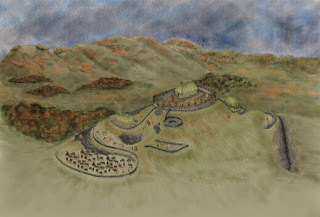
For years, scholars thought a Scottish Dark Ages hill fort that met a violent, fiery end was a stronghold of the Pictish people. But new research shows Trusty’s Hill was likely the royal stronghold of the Britons’ mysterious Rheged kingdom in Galloway.
During the attack, the fire that burned the fort lasted long enough and generated enough heat that it vitrified the stones of its ramparts. The same thing happened to the Mote of Mark, another hill fort also in southwest Scotland, in Galloway.
Thus came the demise of the kingdom of Rheged in the 7th century AD. A kingdom that had once dominated Scotland and northern Britain.

GUARD Archaeology Ltd. produced this re-enactment of the conflagration at Trusty’s Hill. (GUARD Archaeology Ltd)
The location of the kingdom of Rheged had been lost to history, though one of its kings, Urien, was celebrated centuries later in the poet Taliesin’s works.
Several years ago archaeologists decided to take a second look at Trusty’s Hill, drawn there by enigmatic Pictish symbols. The symbols at Trusty’s Hill are far south of where Pictish marks are usually found, which presented something of a mystery.
Trusty’s Hill was assumed to be a stronghold of what became known as the Galloway Picts. Archaeologists, with a staff of 60 people, launched The Galloway Picts Project in 2012 to verify or refute the idea.
An article on Guard Archaeology’s website quotes Ronan Toolis, the lead archaeologist:
… far from validating the existence of ‘Galloway Picts’, the archaeological context revealed by our excavation instead suggests the carvings relate to a royal stronghold and place of inauguration for the local Britons of Galloway around AD 600. Examined in the context of contemporary sites across Scotland and northern England, the archaeological evidence suggests that Galloway may have been the heart of the lost Dark Age kingdom of Rheged, a kingdom that was in the late sixth century pre-eminent amongst the kingdoms of the north.
An article on the Galloway Picts site explains that when local nobles weren’t making war, they were likely marrying, hiring laborers and trading with other cultures in northern Britain and Ireland. They presumably absorbed foreign elements into their own cultures.
“This is the context for the Pictish Symbols at Trusty’s Hill, where the Pictish Inscription either represents the presence of Picts there, perhaps through marriage into a local family, or where a local family aspired to be seen as Picts,” the Galloway Picts site states.
Excavations since 2012 have shown that in the decades around 600 AD, the hill’s summit had fortifications that included a rampart of timber and stone. Other defenses and enclosures on the lower slopes of the hill made it a nucleated fort. Such forts were used by high-status people in Scotland in the medieval period, says Guard Archaeology.
People entering the fort saw a rock-cut basin on one side and an outcropping on the other, upon which were carved two Pictish symbols. Guard Archaeology calls this a rite of passage into the fort, where royal inaugurations took place. Upon entering, guests would see the king’s feasting hall to the west, and a smith’s workshop to the east. The smith likely worked with gold, silver, bronze, and iron.
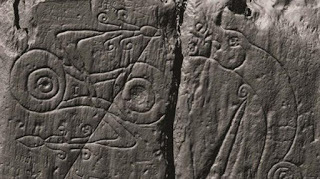
One of the Pictish symbols at the gate. Because there is no Rosetta Stone for the Picts, the meaning of the symbol has been lost. ( DGNHAS / CDDV )
“The layout of this fort was complex, each element deliberately formed to exhibit the power and status of its household,” Guard Archaeology states .
Traders came from across Europe, Britain, and Ireland, lured in part by copper and lead, which were mined nearby.
Other activities on Trusty’s Hill included feasting, spinning wool, and preparing leather. The household ate beef, oats, and barley, much the same as their Iron Age ancestors. The people who lived at Trusty’s Hill didn’t farm, according to excavation co-director Dr. Christopher Bowles , Scottish Borders Council Archaeologist.
“Instead, this household's wealth relied on their control of farming, animal husbandry and the management of local natural resources - minerals and timber - from an estate probably spanning the wider landscape of the Fleet valley and estuary. Control was maintained by bonding the people of this land and the districts beyond to the royal household, by gifts, promises of protection and the bounties of raiding and warfare.”
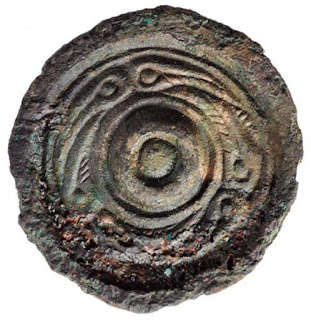
Anglo-saxon style bronze jewelry that was originally gilded and silvered. It was probably brought to Trusty’s Hill as loot. ( DGNHAS / GUARD Archaeology Ltd )
Trusty’s Hill had the highest status in comparison to other similar forts around Galloway. Those Dark Age forts include Whithorn, Kirkmadrine and the Mote of Mark. But only
Trusty’s Hill had evidence of royal inauguration and so scholars think it dominated the local hierarchy.
Galloway has been called the cradle of Christianity in Scotland, which could only be accomplished if it had sufficient lands and resources and if the locals were literate and well-connected on the international scene.
In the 7th century, the kingdom of Rheged failed and died out in apparent violent conflict. Trusty’s Hill also may have been burnt by its own people who wanted to destroy it after abandonment. To vitrify the stones of the forts, the fires had to last for days or weeks and be especially hot. Past Horizons says the smoke and flames generated by the fires may have also been meant to send a message of dominance and threat to anyone in the vicinity.
Top Image: This is a reproduction of Trusty’s Hill, erroneously thought to be a Pict site but now believed to have been the stronghold of the lost British kingdom of Rheged of 600 AD or so. Source: DGNHAS / GUARD Archaeology Ltd .
By Mark Miller

For years, scholars thought a Scottish Dark Ages hill fort that met a violent, fiery end was a stronghold of the Pictish people. But new research shows Trusty’s Hill was likely the royal stronghold of the Britons’ mysterious Rheged kingdom in Galloway.
During the attack, the fire that burned the fort lasted long enough and generated enough heat that it vitrified the stones of its ramparts. The same thing happened to the Mote of Mark, another hill fort also in southwest Scotland, in Galloway.
Thus came the demise of the kingdom of Rheged in the 7th century AD. A kingdom that had once dominated Scotland and northern Britain.

GUARD Archaeology Ltd. produced this re-enactment of the conflagration at Trusty’s Hill. (GUARD Archaeology Ltd)
The location of the kingdom of Rheged had been lost to history, though one of its kings, Urien, was celebrated centuries later in the poet Taliesin’s works.
Several years ago archaeologists decided to take a second look at Trusty’s Hill, drawn there by enigmatic Pictish symbols. The symbols at Trusty’s Hill are far south of where Pictish marks are usually found, which presented something of a mystery.
Trusty’s Hill was assumed to be a stronghold of what became known as the Galloway Picts. Archaeologists, with a staff of 60 people, launched The Galloway Picts Project in 2012 to verify or refute the idea.
An article on Guard Archaeology’s website quotes Ronan Toolis, the lead archaeologist:
… far from validating the existence of ‘Galloway Picts’, the archaeological context revealed by our excavation instead suggests the carvings relate to a royal stronghold and place of inauguration for the local Britons of Galloway around AD 600. Examined in the context of contemporary sites across Scotland and northern England, the archaeological evidence suggests that Galloway may have been the heart of the lost Dark Age kingdom of Rheged, a kingdom that was in the late sixth century pre-eminent amongst the kingdoms of the north.
An article on the Galloway Picts site explains that when local nobles weren’t making war, they were likely marrying, hiring laborers and trading with other cultures in northern Britain and Ireland. They presumably absorbed foreign elements into their own cultures.
“This is the context for the Pictish Symbols at Trusty’s Hill, where the Pictish Inscription either represents the presence of Picts there, perhaps through marriage into a local family, or where a local family aspired to be seen as Picts,” the Galloway Picts site states.
Excavations since 2012 have shown that in the decades around 600 AD, the hill’s summit had fortifications that included a rampart of timber and stone. Other defenses and enclosures on the lower slopes of the hill made it a nucleated fort. Such forts were used by high-status people in Scotland in the medieval period, says Guard Archaeology.
People entering the fort saw a rock-cut basin on one side and an outcropping on the other, upon which were carved two Pictish symbols. Guard Archaeology calls this a rite of passage into the fort, where royal inaugurations took place. Upon entering, guests would see the king’s feasting hall to the west, and a smith’s workshop to the east. The smith likely worked with gold, silver, bronze, and iron.

One of the Pictish symbols at the gate. Because there is no Rosetta Stone for the Picts, the meaning of the symbol has been lost. ( DGNHAS / CDDV )
“The layout of this fort was complex, each element deliberately formed to exhibit the power and status of its household,” Guard Archaeology states .
Traders came from across Europe, Britain, and Ireland, lured in part by copper and lead, which were mined nearby.
Other activities on Trusty’s Hill included feasting, spinning wool, and preparing leather. The household ate beef, oats, and barley, much the same as their Iron Age ancestors. The people who lived at Trusty’s Hill didn’t farm, according to excavation co-director Dr. Christopher Bowles , Scottish Borders Council Archaeologist.
“Instead, this household's wealth relied on their control of farming, animal husbandry and the management of local natural resources - minerals and timber - from an estate probably spanning the wider landscape of the Fleet valley and estuary. Control was maintained by bonding the people of this land and the districts beyond to the royal household, by gifts, promises of protection and the bounties of raiding and warfare.”

Anglo-saxon style bronze jewelry that was originally gilded and silvered. It was probably brought to Trusty’s Hill as loot. ( DGNHAS / GUARD Archaeology Ltd )
Trusty’s Hill had the highest status in comparison to other similar forts around Galloway. Those Dark Age forts include Whithorn, Kirkmadrine and the Mote of Mark. But only
Trusty’s Hill had evidence of royal inauguration and so scholars think it dominated the local hierarchy.
Galloway has been called the cradle of Christianity in Scotland, which could only be accomplished if it had sufficient lands and resources and if the locals were literate and well-connected on the international scene.
In the 7th century, the kingdom of Rheged failed and died out in apparent violent conflict. Trusty’s Hill also may have been burnt by its own people who wanted to destroy it after abandonment. To vitrify the stones of the forts, the fires had to last for days or weeks and be especially hot. Past Horizons says the smoke and flames generated by the fires may have also been meant to send a message of dominance and threat to anyone in the vicinity.
Top Image: This is a reproduction of Trusty’s Hill, erroneously thought to be a Pict site but now believed to have been the stronghold of the lost British kingdom of Rheged of 600 AD or so. Source: DGNHAS / GUARD Archaeology Ltd .
By Mark Miller
Published on January 25, 2017 02:00
January 24, 2017
Archaeologists are Ecstatic that a Major Viking Age Manor is Finally Found in Sweden
Ancient Origins
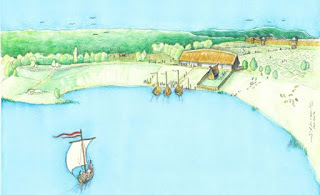
For centuries it has been speculated where the manor of the royal bailiff of Birka, Herigar, might have been located. New geophysical results provide evidence of its location at Korshamn, outside the town rampart of the Viking Age proto-town Birka in Sweden.
The results will be published in the international scientific journal Archäologisches Korrespondenzblatt.
During spring of 2016 a number of large presumed house terraces were identified by the authors at Korshamn. As a consequence high resolution geophysical surveys using ground-penetrating radar were carried out in September 2016. Korshamn is one of the main harbour bays of the island of Björkö, situated outside the town boundaries of the Viking town of Birka. The survey revealed a major Viking period hall on the site, with a length of around 40 meters. Based on the land upheaval the area of the Viking hall can be dated to sometime after 810 AD. The hall is connected to a large fenced area that stretches towards the harbour basin.
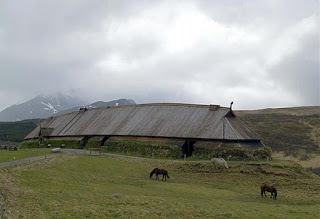
Example of a reconstructed Viking long house in the Vikingmuseum in Borg, Vestvågøy/Lofoten, Norway. (Jörg Hempel/ CC BY SA 2.0 )
"This kind of Viking period high status manors has previously only been identified at a few places in southern Scandinavia, for instance at Tissø and Lejre in Denmark. It is known that the fenced area at such manors was linked to religious activities" says Johan Runer, archaeologist at the Stockholm county museum.
During the survey a predecessor for the Viking Age manor was also identified at the site: a high status manor that existed during the Vendel period, prior to the establishment of the Viking Age town of Birka. Both the identified buildings and their continued use from the Vendel period to the Viking Age correlate well with the "ancestral property" of Birka's royal bailiff Herigar as mentioned in Rimbert's Vita Anskarii. Herigar was Christianized by Ansgar, archbishop of Hamburg-Bremen, during his first mission c. 830 AD, and he built the first church on his land.
"The consequences of our discoveries cannot be overestimated: in terms of the emergence of the Viking town of Birka, its royal administration and the earliest Christian mission to Scandinavia," says Sven Kalmring, researcher at the Zentrum für Baltische und Skandinavische Archäologie, Schleswig.

Map of Birka. ( Holger.Ellgaard/CC BY SA 3.0 )
The new discovery was made just outside the Viking town’s boundaries. "The results highlight the benefits of using non-intrusive geophysical surveys for the detection of archaeological features and, once again, prove to be an invaluable tool for documenting Iron Age building remains in Scandinavia," says Andreas Viberg, researcher at the Archaeological Research Laboratory at Stockholm University.
The research is a collaboration between Zentrum für Baltische und Skandinavische Archäologie, Stockholm county museum and the Archaeological Research Laboratory, Stockholm University.
The results will be published in the international scientific journal Archäologisches Korrespondenzblatt .
Top image: Reconstruction of the Viking age manor. Source: Jacques Vincent
The article, originally titled ‘ Major Viking Age manor discovered at Birka, Sweden’ was originally published on Science Daily. Source: Stockholm University. " Major Viking Age manor discovered at Birka, Sweden ." ScienceDaily. ScienceDaily, 19 January 2017.

For centuries it has been speculated where the manor of the royal bailiff of Birka, Herigar, might have been located. New geophysical results provide evidence of its location at Korshamn, outside the town rampart of the Viking Age proto-town Birka in Sweden.
The results will be published in the international scientific journal Archäologisches Korrespondenzblatt.
During spring of 2016 a number of large presumed house terraces were identified by the authors at Korshamn. As a consequence high resolution geophysical surveys using ground-penetrating radar were carried out in September 2016. Korshamn is one of the main harbour bays of the island of Björkö, situated outside the town boundaries of the Viking town of Birka. The survey revealed a major Viking period hall on the site, with a length of around 40 meters. Based on the land upheaval the area of the Viking hall can be dated to sometime after 810 AD. The hall is connected to a large fenced area that stretches towards the harbour basin.

Example of a reconstructed Viking long house in the Vikingmuseum in Borg, Vestvågøy/Lofoten, Norway. (Jörg Hempel/ CC BY SA 2.0 )
"This kind of Viking period high status manors has previously only been identified at a few places in southern Scandinavia, for instance at Tissø and Lejre in Denmark. It is known that the fenced area at such manors was linked to religious activities" says Johan Runer, archaeologist at the Stockholm county museum.
During the survey a predecessor for the Viking Age manor was also identified at the site: a high status manor that existed during the Vendel period, prior to the establishment of the Viking Age town of Birka. Both the identified buildings and their continued use from the Vendel period to the Viking Age correlate well with the "ancestral property" of Birka's royal bailiff Herigar as mentioned in Rimbert's Vita Anskarii. Herigar was Christianized by Ansgar, archbishop of Hamburg-Bremen, during his first mission c. 830 AD, and he built the first church on his land.
"The consequences of our discoveries cannot be overestimated: in terms of the emergence of the Viking town of Birka, its royal administration and the earliest Christian mission to Scandinavia," says Sven Kalmring, researcher at the Zentrum für Baltische und Skandinavische Archäologie, Schleswig.

Map of Birka. ( Holger.Ellgaard/CC BY SA 3.0 )
The new discovery was made just outside the Viking town’s boundaries. "The results highlight the benefits of using non-intrusive geophysical surveys for the detection of archaeological features and, once again, prove to be an invaluable tool for documenting Iron Age building remains in Scandinavia," says Andreas Viberg, researcher at the Archaeological Research Laboratory at Stockholm University.
The research is a collaboration between Zentrum für Baltische und Skandinavische Archäologie, Stockholm county museum and the Archaeological Research Laboratory, Stockholm University.
The results will be published in the international scientific journal Archäologisches Korrespondenzblatt .
Top image: Reconstruction of the Viking age manor. Source: Jacques Vincent
The article, originally titled ‘ Major Viking Age manor discovered at Birka, Sweden’ was originally published on Science Daily. Source: Stockholm University. " Major Viking Age manor discovered at Birka, Sweden ." ScienceDaily. ScienceDaily, 19 January 2017.
Published on January 24, 2017 01:30
January 23, 2017
Kumbhalgarh: The Great Wall You Have Never Heard Of (and it is NOT in China)
Ancient Origins
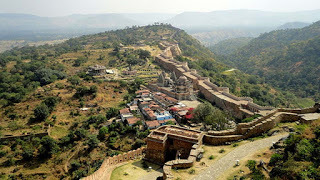
The wall that encircles the ancient fort of Kumbhalgarh is one of the biggest secrets in India, and possibly the entire planet. Guarding a massive fort that contains over 300 ancient temples, the little-known wall was said to be constructed almost 500 years ago in tandem with Kumbhalgarh Fort itself. However, a retired archaeologist now suggests another immense wall may be even older.
Historians Refer to it as the “Great Wall” of India
Most of us are aware of the Great Wall of China, but apparently, many also ignore a massive wall that stands tall in India. The fort of Kumbhalgarh is the second most significant fort of Rajasthan after Chittorgarh and extends to the amazing length of 36 kilometers (22.5 miles).
The wall that surrounds it, which history buffs love calling the “Great Wall of India”, is speculated to be 80 kilometers (50 miles) long, a fact that would make it India’s longest fortification and the second longest wall worldwide, only behind China’s.
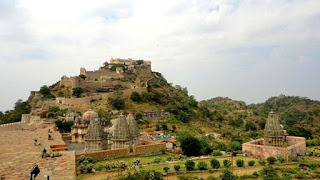
Kumbhalgarh Fort and wall. (CC BY SA 3.0)
Ιn 2013, at the 37th session of the World Heritage Committee held in Phnom Penh, Cambodia, Kumbhalgarh Fort, alongside five different fortifications of Rajasthan, was proudly pronounced a UNESCO World Heritage Site under the gathering Hill Forts of Rajasthan. However, it still remains widely unknown for some reason, despite its massive construction and beautiful architecture.
At its widest sections, the wall is 15 meters (49.2 ft.) thick, and impressively built with thousands of stone bricks and decorative flourishes along the top - making this just as attractive as a tourist destination as it once was effective as a deterrent.
The Wall’s History and Mysteries Work on Kumbhalgarh only began in 1443, nearly fifty years before Columbus sailed the Atlantic Ocean and discovered another, even larger, wall in China. Situated in the state of Rajasthan in the west of India, constructions started by the local Maharana, Rana Kumbha in that year.
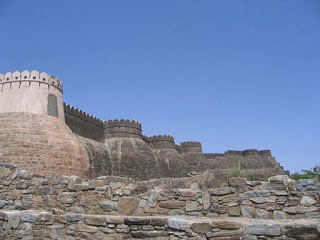
Walls of the Kumbhalgarh Fort. (Shivam Chaturvedi/CC BY SA 3.0)
It took over a century to construct the wall and it was later enlarged in the 19th century. The Kumbhalgarh Fort, protected by the massive wall, was built high on a hill so it could dominate and observe the landscape from a distance. Altogether the wall has seven gateways, and it is believed that during the reign of the Maharana, the wall held so many lamps that it enabled the local farmers to work both day and night.
Even more precious to the inhabitants of Kumbhalgarh, the wall mainly protected over 360 temples.

Jain Temple in the Kumbalgarh fortress. (CC BY SA 4.0)
Now, Narayan Vyas, a man who made several surveys of a wall between Bhopal and Jabalpur after retiring from the Archaeological Survey of India a decade ago, believes that that the temple relics and the wall could be even older than most historians think, dating somewhere from the 10th to 11th century AD, when warrior clans ruled the heart of India
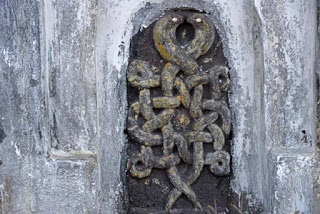
Two entwined snakes stand at one end of the wall, near Gorakhpur, India. (Pratik Chorge/HT PHOTO)
He told Hindustan Times, “This could have been the border of the Parmar kingdom,” referring to the Rajputs that dominated west-central India between the 9th and 13th centuries. He suggests that the wall may have been used to mark their territory against the Kalachuris, “They fought a lot, and the wall was probably a Parmar effort to keep them out.”
Vyas also admits that this is just speculation for now and that further research is needed in order to prove these theories to be historically accurate, “All we need is evidence to confirm what we suspect – that we’ve found the remnants of a 1,000-year-old realm,” Vyas says.
Questions
Rahman Ali, a historian who has written a book on the Parmar sites and visited them in 1975, might admit that he didn’t examine it too closely, but says that the wall still didn’t look Parmar to him. He states:
“There is a tendency to ascribe everything old from this region to the Parmars, but the dynasty would have been crumbling in the 12th century, not building massive walls. The standardized stone barricades may be much younger, perhaps even 17th-century British-made; but these areas weren’t important to the Raj. Why would they build a long wall and abandon it?”
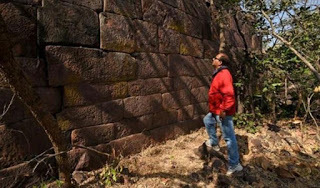
Examining the immense wall. (Pratik Chorge/HT Photo)
Is it India’s Great Wall? Although the mystery remains and heated debates between historians may have only started, it is certain that locals are extremely proud of this giant structure and their history. They are also optimistic for the area’s future when it comes to tourism.
Top Image: Aerial view of a portion of the Kumbhalgarh wall. Source: Heman kumar meena/CC BY SA 3.0
By Theodoros Karasavvas

The wall that encircles the ancient fort of Kumbhalgarh is one of the biggest secrets in India, and possibly the entire planet. Guarding a massive fort that contains over 300 ancient temples, the little-known wall was said to be constructed almost 500 years ago in tandem with Kumbhalgarh Fort itself. However, a retired archaeologist now suggests another immense wall may be even older.
Historians Refer to it as the “Great Wall” of India
Most of us are aware of the Great Wall of China, but apparently, many also ignore a massive wall that stands tall in India. The fort of Kumbhalgarh is the second most significant fort of Rajasthan after Chittorgarh and extends to the amazing length of 36 kilometers (22.5 miles).
The wall that surrounds it, which history buffs love calling the “Great Wall of India”, is speculated to be 80 kilometers (50 miles) long, a fact that would make it India’s longest fortification and the second longest wall worldwide, only behind China’s.

Kumbhalgarh Fort and wall. (CC BY SA 3.0)
Ιn 2013, at the 37th session of the World Heritage Committee held in Phnom Penh, Cambodia, Kumbhalgarh Fort, alongside five different fortifications of Rajasthan, was proudly pronounced a UNESCO World Heritage Site under the gathering Hill Forts of Rajasthan. However, it still remains widely unknown for some reason, despite its massive construction and beautiful architecture.
At its widest sections, the wall is 15 meters (49.2 ft.) thick, and impressively built with thousands of stone bricks and decorative flourishes along the top - making this just as attractive as a tourist destination as it once was effective as a deterrent.
The Wall’s History and Mysteries Work on Kumbhalgarh only began in 1443, nearly fifty years before Columbus sailed the Atlantic Ocean and discovered another, even larger, wall in China. Situated in the state of Rajasthan in the west of India, constructions started by the local Maharana, Rana Kumbha in that year.

Walls of the Kumbhalgarh Fort. (Shivam Chaturvedi/CC BY SA 3.0)
It took over a century to construct the wall and it was later enlarged in the 19th century. The Kumbhalgarh Fort, protected by the massive wall, was built high on a hill so it could dominate and observe the landscape from a distance. Altogether the wall has seven gateways, and it is believed that during the reign of the Maharana, the wall held so many lamps that it enabled the local farmers to work both day and night.
Even more precious to the inhabitants of Kumbhalgarh, the wall mainly protected over 360 temples.

Jain Temple in the Kumbalgarh fortress. (CC BY SA 4.0)
Now, Narayan Vyas, a man who made several surveys of a wall between Bhopal and Jabalpur after retiring from the Archaeological Survey of India a decade ago, believes that that the temple relics and the wall could be even older than most historians think, dating somewhere from the 10th to 11th century AD, when warrior clans ruled the heart of India

Two entwined snakes stand at one end of the wall, near Gorakhpur, India. (Pratik Chorge/HT PHOTO)
He told Hindustan Times, “This could have been the border of the Parmar kingdom,” referring to the Rajputs that dominated west-central India between the 9th and 13th centuries. He suggests that the wall may have been used to mark their territory against the Kalachuris, “They fought a lot, and the wall was probably a Parmar effort to keep them out.”
Vyas also admits that this is just speculation for now and that further research is needed in order to prove these theories to be historically accurate, “All we need is evidence to confirm what we suspect – that we’ve found the remnants of a 1,000-year-old realm,” Vyas says.
Questions
Rahman Ali, a historian who has written a book on the Parmar sites and visited them in 1975, might admit that he didn’t examine it too closely, but says that the wall still didn’t look Parmar to him. He states:
“There is a tendency to ascribe everything old from this region to the Parmars, but the dynasty would have been crumbling in the 12th century, not building massive walls. The standardized stone barricades may be much younger, perhaps even 17th-century British-made; but these areas weren’t important to the Raj. Why would they build a long wall and abandon it?”

Examining the immense wall. (Pratik Chorge/HT Photo)
Is it India’s Great Wall? Although the mystery remains and heated debates between historians may have only started, it is certain that locals are extremely proud of this giant structure and their history. They are also optimistic for the area’s future when it comes to tourism.
Top Image: Aerial view of a portion of the Kumbhalgarh wall. Source: Heman kumar meena/CC BY SA 3.0
By Theodoros Karasavvas
Published on January 23, 2017 01:30
January 22, 2017
Political Intrigue: The Fake News that Sealed the Fate of Antony and Cleopatra
Ancient Origins

Eve MacDonald / The Conversation
The papers and social media are today full of claims of fake news; back and forth the accusations fly that one side of the political divide in the US has been filling the world with lies in order to discredit the other. We used to call this propaganda; now it’s fake news.
One of the most egregious examples of this takes us back to ancient Rome and to the very end of the Republic, when almost a century of civil war, chaos and political assassinations had led the Roman government to the brink of collapse. It was the time of the so-called Second Triumvirate. The alliance between Octavian, the powerful heir of Julius Caesar, and his right-hand man, Marcus Antonius (Mark Antony), was crumbling and two sides had formed – a clash was inevitable.
It is a well-known story – Mark Antony claimed the Eastern Roman Empire as his fiefdom and had moved in with the alluring Cleopatra in Egypt. Meanwhile, his main rival, Octavian (later Augustus Caesar), was in Rome, where the ability to influence the governing Senate and the people of the city still mattered.
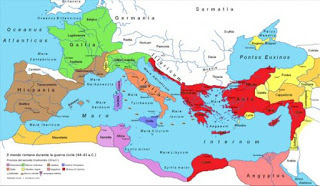
Map of the Roman Republic in 43 BC after the establishment of the Second Triumvirate: Antony (green), Lepidus (brown), Octavian (purple), Triumvirs collectively (orange/peach), Sextus Pompey (blue), The Liberators (red), Rome’s client kingdoms (yellow), Ptolemaic Egypt (pink). (CC BY SA 3.0)
There was a ferocious propaganda war between the two sides in full play by 33BC as both vied for public support and the military authority to sway events. Just as now, there was a lot at stake –in 33BC it was the rule of an Empire that dominated the whole of the Mediterranean.
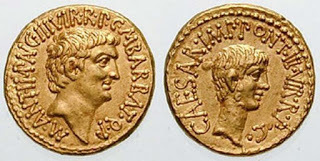
Roman aureus with the portraits of Mark Antony (left) and Octavian (right), issued to celebrate the establishment of the Second Triumvirate by Octavian, Antony, and Marcus Lepidus in 43 BC. Both sides bear the inscription "III VIR R P C", meaning "One of Three Men for the Regulation of the Republic." (Classical Numismatic Group, Inc/CC BY SA 2.5)
Master of the Dark Arts
The young Octavian would eventually prove to be the master of propaganda – and, as he was also physically in Italy, unlike Antony who was in Egypt, he was able to exercise far more influence over Rome and the senate.
Yet it would be a piece of fake news that was to be the proverbial straw that broke the camel’s back. Octavian managed to get hold of a document that he claimed was Antony’s official will and testament – and what a document it turned out to be.
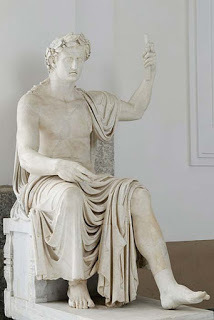
A colossal statue of a seated Augustus (Octavian) with a laurel crown. (Marie-Lan Nguyen/CC BY 2.5)
Whether it was real or not – and scholars debate this point still – the will contained such inflammatory claims that it set the Roman people against Antony. Octavian read this document aloud in the Senate house (according to Plutarch’s Life of Antony, 58) and he made it widely available by getting the Senate to issue a decree that was posted in the forum and sent out widely through the empire by messengers. This way, Octavian convinced the people of Rome – and Antony’s many allies in the Senate – that Antony had lost his head and given himself over to the allure and despotism of Cleopatra, queen of Egypt.
The document played on many of the anti-eastern (and anti-Cleopatra) prejudices of the ancient Romans, traditional views that were suspicious of the wealth and luxuries of the east and of powerful women. It appeared to confirm that Antony intended to leave legacies to his children with Cleopatra (they had three children: twins Cleopatra Selene and Alexander Helios, and a son named Ptolemy Philadelphus) that included large pieces of Roman-held territory in the eastern Mediterranean.
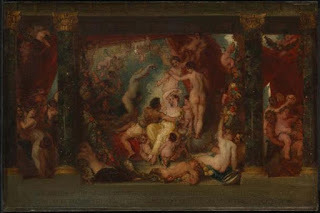
Intemperance' (c. 1802) by Thomas Stothard. (CC BY NC ND 3.0) this painting shows Mark Antony embracing Cleopatra as she drops a pearl into her goblet of wine.
The will also declared Caesarion, the son of Cleopatra and Julius Caesar, Caesar’s legitimate successor. This was an extremely inflammatory claim since it could undermine Octavian – as Caesar’s adopted son – in the eyes of the veterans still loyal to the Julian family.
The document also claimed that Antony’s burial should be in the mausoleum of the Ptolemaic kings in Alexandria. This last wish was considered the most atrocious in the Roman eye, held up by Octavian as particular proof that Antony really just wanted to be a despotic ruler and that if he came to lead would take Rome on the road to monarchy.
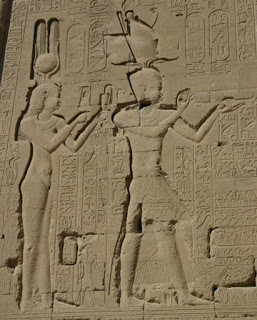
A relief of Cleopatra VII and Caesarion at the temple of Dendera, Egypt. (CC BY SA 3.0)
Dodgy Dossier
What is so intriguing is that whether the document was a piece of fake news or the real thing is no longer of any importance. The will proved to be just the sort of propaganda victory that Octavian had hoped for. The senate in Rome moved to strip Mark Antony of his “imperium” (his legal right to lead the Roman armies he commanded) and without it he was not legally in command of his legions.
It made Antony a traitor and that made it much easier to turn people against him, and declare war. And war was indeed declared by the Roman Senate – interestingly on Cleopatra as queen of Egypt rather than Antony. When the two sides met in battle in 31BC at Actium, Octavian’s victory and the subsequent suicide of Antony and Cleopatra left him as the sole ruler of Rome, and he would become Rome’s first emperor, taking the name Augustus
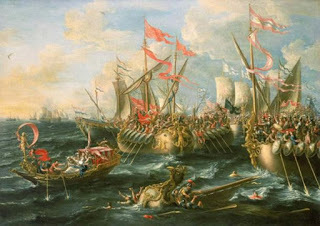
The Battle of Actium, September 2, 31 BC. (1672) By Laureys a Castro. (Public Domain)
As history is written by the victorious, this version of Mark Antony became the accepted part of the story. The attraction of blaming an exotic woman, the eastern queen Cleopatra, for corrupting Antony was the tale that posterity has accepted. The popular depictions of Antony, from Shakespeare through to the classic 1960s film starring Elizabeth Taylor and Richard Burton, reinforce the narrative that Octavian had taken such pains to publicise: Antony was a man who had lost his head and all Roman sense of propriety for the love of a woman.
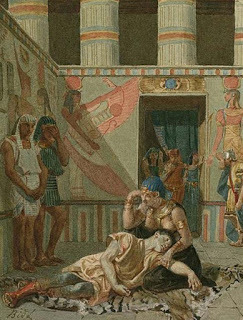
A late 19th century painting of Act IV, Scene 15 of Shakespeare's Antony and Cleopatra: Cleopatra holds Antony as he dies. By Alexandre Bidas. (Folger Shakespeare Library/ CC BY SA 4.0 )
Top Image: Cleopatra's Banquet. By Gerard de Lairesse. Source: Public Domain
The article, originally titled ‘ The fake news that sealed the fate of Antony and Cleopatra’ by Eve MacDonald was originally published on The Conversation and has republished under a Creative Commons license.

Eve MacDonald / The Conversation
The papers and social media are today full of claims of fake news; back and forth the accusations fly that one side of the political divide in the US has been filling the world with lies in order to discredit the other. We used to call this propaganda; now it’s fake news.
One of the most egregious examples of this takes us back to ancient Rome and to the very end of the Republic, when almost a century of civil war, chaos and political assassinations had led the Roman government to the brink of collapse. It was the time of the so-called Second Triumvirate. The alliance between Octavian, the powerful heir of Julius Caesar, and his right-hand man, Marcus Antonius (Mark Antony), was crumbling and two sides had formed – a clash was inevitable.
It is a well-known story – Mark Antony claimed the Eastern Roman Empire as his fiefdom and had moved in with the alluring Cleopatra in Egypt. Meanwhile, his main rival, Octavian (later Augustus Caesar), was in Rome, where the ability to influence the governing Senate and the people of the city still mattered.

Map of the Roman Republic in 43 BC after the establishment of the Second Triumvirate: Antony (green), Lepidus (brown), Octavian (purple), Triumvirs collectively (orange/peach), Sextus Pompey (blue), The Liberators (red), Rome’s client kingdoms (yellow), Ptolemaic Egypt (pink). (CC BY SA 3.0)
There was a ferocious propaganda war between the two sides in full play by 33BC as both vied for public support and the military authority to sway events. Just as now, there was a lot at stake –in 33BC it was the rule of an Empire that dominated the whole of the Mediterranean.

Roman aureus with the portraits of Mark Antony (left) and Octavian (right), issued to celebrate the establishment of the Second Triumvirate by Octavian, Antony, and Marcus Lepidus in 43 BC. Both sides bear the inscription "III VIR R P C", meaning "One of Three Men for the Regulation of the Republic." (Classical Numismatic Group, Inc/CC BY SA 2.5)
Master of the Dark Arts
The young Octavian would eventually prove to be the master of propaganda – and, as he was also physically in Italy, unlike Antony who was in Egypt, he was able to exercise far more influence over Rome and the senate.
Yet it would be a piece of fake news that was to be the proverbial straw that broke the camel’s back. Octavian managed to get hold of a document that he claimed was Antony’s official will and testament – and what a document it turned out to be.

A colossal statue of a seated Augustus (Octavian) with a laurel crown. (Marie-Lan Nguyen/CC BY 2.5)
Whether it was real or not – and scholars debate this point still – the will contained such inflammatory claims that it set the Roman people against Antony. Octavian read this document aloud in the Senate house (according to Plutarch’s Life of Antony, 58) and he made it widely available by getting the Senate to issue a decree that was posted in the forum and sent out widely through the empire by messengers. This way, Octavian convinced the people of Rome – and Antony’s many allies in the Senate – that Antony had lost his head and given himself over to the allure and despotism of Cleopatra, queen of Egypt.
The document played on many of the anti-eastern (and anti-Cleopatra) prejudices of the ancient Romans, traditional views that were suspicious of the wealth and luxuries of the east and of powerful women. It appeared to confirm that Antony intended to leave legacies to his children with Cleopatra (they had three children: twins Cleopatra Selene and Alexander Helios, and a son named Ptolemy Philadelphus) that included large pieces of Roman-held territory in the eastern Mediterranean.

Intemperance' (c. 1802) by Thomas Stothard. (CC BY NC ND 3.0) this painting shows Mark Antony embracing Cleopatra as she drops a pearl into her goblet of wine.
The will also declared Caesarion, the son of Cleopatra and Julius Caesar, Caesar’s legitimate successor. This was an extremely inflammatory claim since it could undermine Octavian – as Caesar’s adopted son – in the eyes of the veterans still loyal to the Julian family.
The document also claimed that Antony’s burial should be in the mausoleum of the Ptolemaic kings in Alexandria. This last wish was considered the most atrocious in the Roman eye, held up by Octavian as particular proof that Antony really just wanted to be a despotic ruler and that if he came to lead would take Rome on the road to monarchy.

A relief of Cleopatra VII and Caesarion at the temple of Dendera, Egypt. (CC BY SA 3.0)
Dodgy Dossier
What is so intriguing is that whether the document was a piece of fake news or the real thing is no longer of any importance. The will proved to be just the sort of propaganda victory that Octavian had hoped for. The senate in Rome moved to strip Mark Antony of his “imperium” (his legal right to lead the Roman armies he commanded) and without it he was not legally in command of his legions.
It made Antony a traitor and that made it much easier to turn people against him, and declare war. And war was indeed declared by the Roman Senate – interestingly on Cleopatra as queen of Egypt rather than Antony. When the two sides met in battle in 31BC at Actium, Octavian’s victory and the subsequent suicide of Antony and Cleopatra left him as the sole ruler of Rome, and he would become Rome’s first emperor, taking the name Augustus

The Battle of Actium, September 2, 31 BC. (1672) By Laureys a Castro. (Public Domain)
As history is written by the victorious, this version of Mark Antony became the accepted part of the story. The attraction of blaming an exotic woman, the eastern queen Cleopatra, for corrupting Antony was the tale that posterity has accepted. The popular depictions of Antony, from Shakespeare through to the classic 1960s film starring Elizabeth Taylor and Richard Burton, reinforce the narrative that Octavian had taken such pains to publicise: Antony was a man who had lost his head and all Roman sense of propriety for the love of a woman.

A late 19th century painting of Act IV, Scene 15 of Shakespeare's Antony and Cleopatra: Cleopatra holds Antony as he dies. By Alexandre Bidas. (Folger Shakespeare Library/ CC BY SA 4.0 )
Top Image: Cleopatra's Banquet. By Gerard de Lairesse. Source: Public Domain
The article, originally titled ‘ The fake news that sealed the fate of Antony and Cleopatra’ by Eve MacDonald was originally published on The Conversation and has republished under a Creative Commons license.
Published on January 22, 2017 01:30
January 21, 2017
Medieval kebabs and pasties: 5 foods you (probably) didn’t know were being eaten in the Middle Ages
History Extra
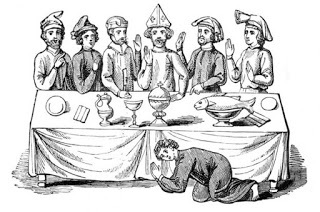
Medieval banquet: saying grace before meal. From engraving after illuminated medieval Royal Manuscript (14 E 3) - Photo by Culture Club/Getty Images
Here, freelance writer George Dobbs reveals five examples of commonplace courtly dishes that wouldn't look too out of place on your dinner table today.
Sweet and sour
Sweet and sour rabbit is one of the more curious dishes included in Maggie Black's The Medieval Cookbook. Found in a collection of 14th-century manuscripts called the Curye on Inglish, it includes sugar, red wine vinegar, currants, onions, ginger and cinnamon (along with plenty of “powdour of peper”) to produce a sticky sauce with more than a hint of the modern Chinese takeaway. The recipe probably dates as far back as the Norman Conquest, when the most surprising ingredient for Saxons would have been rabbit, only recently introduced to England from continental Europe.
Pasta
In the same manuscript we find instructions for pasta production, with fine flour used to “make therof thynne foyles as paper with a roller, drye it hard and seeth it in broth”. This was known as 'losyns', and a typical dish involved layering the pasta with cheese sauce to make another English favourite: lasagne. Sadly the lack of tomatoes meant there was no rich bolognese to go along with the béchamel, but it was still a much-loved dish, and was served at the end of meals to help soak up the large amount of alcohol you were expected to imbibe – much as an oily kebab might today. In Thomas Austin's edition of Two Fifteenth Century Cookery Books, you can find several other pasta recipes, including ravioli and Lesenge Fries – a sugar and saffron doughnut, similar to the modern Italian feast day treats such as frappe or castagnole. The full edition, including hundreds of medieval recipes, can be found online through the University of Michigan database.
Rice dishes
Rice was grown in Europe as early as the 8th century by Spanish Moors. By the 15th century it was produced across Spain and Italy, and exported to all corners of Europe in vast quantities. The brilliant recipe resource www.medievalcookery.com shows the wide variety of ways in which rice was used, including three separate medieval references to a dish called blancmager. Rather than the pudding you might expect, blancmager was actually a soft rice dish, combining chicken or fish with sugar and spices. Due to its bland nature, it was possibly served to invalids as a restorative. There were also sweet rice dishes, including rice drinks and a dish called prymerose, which combined honey, almonds, primroses and rice flour to make a thick rice pudding.
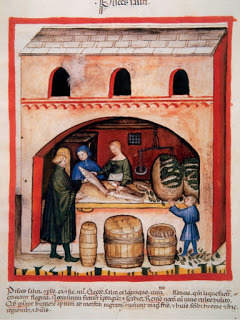
Pasties
Wrapping food in pastry was commonplace in medieval times. It meant that meat could be baked in stone ovens without being burnt or tarnished by soot, while also forming a rich, thick gravy.
Pie crusts were elaborately decorated to show off the status of the host, and diners would often discard it to get to the filling. However, there were also pastry dishes intended to be eaten as a whole. In The Goodman of Paris, translated into English by Eileen Power, we find a recipe for cheese and mushroom pasties, and we're even given instruction on how to pick our ingredients, with “mushrooms of one night... small, red inside and closed at the top” being the most suitable.
Candy
Subtleties are a famous medieval culinary feature. The term actually encompasses the notion of entertainment with food as well as elaborate savoury dishes, but it's most often used to refer to lavish constructions of almond and sugar that were served at the end of the meal.
These weren't the only way to indulge a sweet tooth, however. Maggie Black describes a recipe in the Curye on Inglish that combines pine nuts with sugar, honey and breadcrumbs to give a chewy candy. And long before it was a health food, almond milk was a commonplace drink at medieval tables.
So what have we learned? From just a few examples it's easy to see that, despite technological restrictions, cookery of this period wasn't necessarily unskilled or unpalatable. It's true that a cursory glance over recipe collections reveals odd dishes such as gruel and compost, which look about as appetising as their names suggest. But for every grim oddity there were many more meals that still sound mouthwatering today. In fact, many of our modern favourites may have roots in medieval kitchens.
George Dobbs is a freelance writer who specialises in literature and history.

Medieval banquet: saying grace before meal. From engraving after illuminated medieval Royal Manuscript (14 E 3) - Photo by Culture Club/Getty Images
Here, freelance writer George Dobbs reveals five examples of commonplace courtly dishes that wouldn't look too out of place on your dinner table today.
Sweet and sour
Sweet and sour rabbit is one of the more curious dishes included in Maggie Black's The Medieval Cookbook. Found in a collection of 14th-century manuscripts called the Curye on Inglish, it includes sugar, red wine vinegar, currants, onions, ginger and cinnamon (along with plenty of “powdour of peper”) to produce a sticky sauce with more than a hint of the modern Chinese takeaway. The recipe probably dates as far back as the Norman Conquest, when the most surprising ingredient for Saxons would have been rabbit, only recently introduced to England from continental Europe.
Pasta
In the same manuscript we find instructions for pasta production, with fine flour used to “make therof thynne foyles as paper with a roller, drye it hard and seeth it in broth”. This was known as 'losyns', and a typical dish involved layering the pasta with cheese sauce to make another English favourite: lasagne. Sadly the lack of tomatoes meant there was no rich bolognese to go along with the béchamel, but it was still a much-loved dish, and was served at the end of meals to help soak up the large amount of alcohol you were expected to imbibe – much as an oily kebab might today. In Thomas Austin's edition of Two Fifteenth Century Cookery Books, you can find several other pasta recipes, including ravioli and Lesenge Fries – a sugar and saffron doughnut, similar to the modern Italian feast day treats such as frappe or castagnole. The full edition, including hundreds of medieval recipes, can be found online through the University of Michigan database.
Rice dishes
Rice was grown in Europe as early as the 8th century by Spanish Moors. By the 15th century it was produced across Spain and Italy, and exported to all corners of Europe in vast quantities. The brilliant recipe resource www.medievalcookery.com shows the wide variety of ways in which rice was used, including three separate medieval references to a dish called blancmager. Rather than the pudding you might expect, blancmager was actually a soft rice dish, combining chicken or fish with sugar and spices. Due to its bland nature, it was possibly served to invalids as a restorative. There were also sweet rice dishes, including rice drinks and a dish called prymerose, which combined honey, almonds, primroses and rice flour to make a thick rice pudding.

Pasties
Wrapping food in pastry was commonplace in medieval times. It meant that meat could be baked in stone ovens without being burnt or tarnished by soot, while also forming a rich, thick gravy.
Pie crusts were elaborately decorated to show off the status of the host, and diners would often discard it to get to the filling. However, there were also pastry dishes intended to be eaten as a whole. In The Goodman of Paris, translated into English by Eileen Power, we find a recipe for cheese and mushroom pasties, and we're even given instruction on how to pick our ingredients, with “mushrooms of one night... small, red inside and closed at the top” being the most suitable.
Candy
Subtleties are a famous medieval culinary feature. The term actually encompasses the notion of entertainment with food as well as elaborate savoury dishes, but it's most often used to refer to lavish constructions of almond and sugar that were served at the end of the meal.
These weren't the only way to indulge a sweet tooth, however. Maggie Black describes a recipe in the Curye on Inglish that combines pine nuts with sugar, honey and breadcrumbs to give a chewy candy. And long before it was a health food, almond milk was a commonplace drink at medieval tables.
So what have we learned? From just a few examples it's easy to see that, despite technological restrictions, cookery of this period wasn't necessarily unskilled or unpalatable. It's true that a cursory glance over recipe collections reveals odd dishes such as gruel and compost, which look about as appetising as their names suggest. But for every grim oddity there were many more meals that still sound mouthwatering today. In fact, many of our modern favourites may have roots in medieval kitchens.
George Dobbs is a freelance writer who specialises in literature and history.
Published on January 21, 2017 01:30
January 20, 2017
Remaking the Mausoleum: One of the Seven Wonders of The Ancient World to be Revived
Ancient Origins
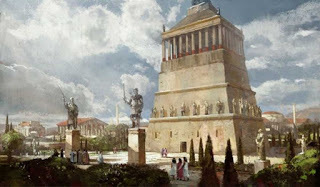
Plans are underway to bring the famed Mausoleum at Halicarnassus back to its former glory. This is the second longest surviving ancient wonder, after the Great Pyramid of Giza. However, the ancient tomb of King Mausolus has fallen into ruins and little remains these days of the marvelous structure that once stood. Archaeologists hope that the reconstruction of the tomb and other local sites will help resurrect interest in the history of the region and bring the ancient tomb back to life.
The Mausoleum is located in Halicarnassus, present day Bodrum, in Turkey. It was built between 353 and 350 BC as the final resting place for Mausolus, the second ruler of Caria from the Hecatomnid dynasty. The building was constructed on top of a hill overlooking the city and created with a mixture of styles from three different cultures – Greek, Lycian, and Egyptian. Mausolus’ grieving widow (and sister), Artemisia II, pulled out all the stops in the creation of his tomb.
Ancient Origins writer Dhwty has provided a description of how the grand Mausoleum looked in its glory days:
“A stone platform was first built, and was enclosed with a courtyard. The top of this platform was reached by a flight of stairs flanked by stone lions. Along the outer walls of the courtyard were statues of various gods and goddesses, whilst mounted stone warriors were stationed at each corner. At the center of the platform was the Mausoleum itself. Whilst the building was constructed of bricks, it was covered with white Proconnesian marble, giving it a splendid look. The first 1/3 of the Mausoleum was a square, tapering block covered with relief sculptures. These reliefs included standard images from the Greek repertoire, including the Centauromachy (the battle between the Lapiths and centaurs) and the Amazonomachy (the battle between the Greeks and Amazons). The next 1/3 of the monument consisted of a set of 36 Ionic columns. Between each column was a statue, and a solid block was constructed behind the columns to bear the bear the weight of the structure’s roof. This roof, which covered the final 1/3 of the building, was a step pyramid with 24 levels, topped with a sculpture of Mausolus and Artemisia riding a four-horsed chariot.”
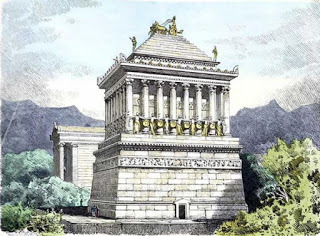
The Mausoleum at Halicarnassus, painting by Ferdinand Knab. (Public Domain)
And now, Hurriyet Daily News reports that Danish archaeologist Professor Poul Pedersen and his assistant Professor John Lund of the University of Southern Denmark have begun working with The Mediterranean Countries Academy Foundation, headed by Özay Kartal, to restore the famous site.
Lonely Planet says that there are only a few ancient elements of the Mausoleum that survived the earthquakes that shook the monument to the ground before the 15th century AD. These are:
“the pre-Mausolean stairways and tomb chambers, the narrow entry to Mausolus’ tomb chamber and a huge green stone that blocked it, the Mausolean drainage system, precinct wall bits and some large fluted marble column drums.”
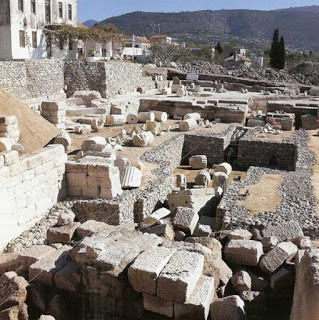
Excavations at the ruins of the Mausoleum. (Kristian Jeppesen)
The restoration of the Mausoleum is one of the two main objectives for The Danish Halikarnassos Project, the other being a wider mission covering the rest of the ancient city of Halicarnassus. Specifically, Hurriyet Daily News says that the project also involves excavating some sites along the way from the Bodrum Harbor to the tomb, unearthing ancient city walls that encircle Bodrum, and excavating a 3,500-year-old hippodrome.
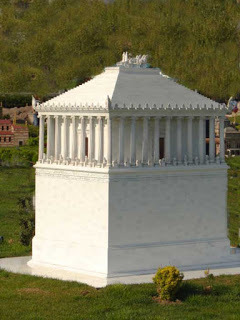
A scale model of a reconstruction of the Mausoleum - one of the versions at Miniatürk, Istanbul. (Nevit Dilmen/CC BY SA 3.0)
Discussing the reason behind the ambitious project, Özay Kartal has said:
“There are many locals in Bodrum who don’t know that Heredotus was born in Bodrum and that the Mausoleum at Halicarnassus is listed as one of the Seven Wonders of the World. This is why our priority is to restitute this mausoleum and open a way from the port to this place. Hundreds of thousands of tourists visiting Bodrum return to their countries without seeing it. We, as the foundation, will organize the International Mausolus Workshop in May to provide information about Bodrum’s history with the participation of academics, historians and archaeologists. This workshop will be a very important step leading to the restitution project of the Mausoleum at Halicarnassus.”
Travelers Today says that there are no dates provided yet for the restoration of the Mausoleum. However, when the ancient structure is restored, there will be at least two of the ancient wonders of the world available for modern eyes to gaze upon once again.
The Seven Wonders of the Ancient World were a list of seven monuments that ancient Greek historians considered the ultimate examples of skill and ingenuity.
As April Holloway has written:
“Today, only one of the Seven Wonders remains intact – the Great Pyramid of Giza. Three of the Wonders – the Colossus of Rhodes, Lighthouse of Alexandria and Mausoleum of Halicarnassus – were destroyed by earthquakes. Two of the Wonders – the Temple of Artemis and Statue of Zeus – were intentionally destroyed by enemy forces, while the final Wonder – the Hanging Gardens of Babylon – has remained a matter of contention for millennia, with some historians questioning whether existed at all.”
Although it is limited as it only covers the Mediterranean and Middle Eastern regions, the seven sites included on the list certainly must have been something spectacular to behold.
Top Image: Painting of what the Mausoleum at Halicarnassus may have looked like. Source: CC BY SA
By Alicia McDermott

Plans are underway to bring the famed Mausoleum at Halicarnassus back to its former glory. This is the second longest surviving ancient wonder, after the Great Pyramid of Giza. However, the ancient tomb of King Mausolus has fallen into ruins and little remains these days of the marvelous structure that once stood. Archaeologists hope that the reconstruction of the tomb and other local sites will help resurrect interest in the history of the region and bring the ancient tomb back to life.
The Mausoleum is located in Halicarnassus, present day Bodrum, in Turkey. It was built between 353 and 350 BC as the final resting place for Mausolus, the second ruler of Caria from the Hecatomnid dynasty. The building was constructed on top of a hill overlooking the city and created with a mixture of styles from three different cultures – Greek, Lycian, and Egyptian. Mausolus’ grieving widow (and sister), Artemisia II, pulled out all the stops in the creation of his tomb.
Ancient Origins writer Dhwty has provided a description of how the grand Mausoleum looked in its glory days:
“A stone platform was first built, and was enclosed with a courtyard. The top of this platform was reached by a flight of stairs flanked by stone lions. Along the outer walls of the courtyard were statues of various gods and goddesses, whilst mounted stone warriors were stationed at each corner. At the center of the platform was the Mausoleum itself. Whilst the building was constructed of bricks, it was covered with white Proconnesian marble, giving it a splendid look. The first 1/3 of the Mausoleum was a square, tapering block covered with relief sculptures. These reliefs included standard images from the Greek repertoire, including the Centauromachy (the battle between the Lapiths and centaurs) and the Amazonomachy (the battle between the Greeks and Amazons). The next 1/3 of the monument consisted of a set of 36 Ionic columns. Between each column was a statue, and a solid block was constructed behind the columns to bear the bear the weight of the structure’s roof. This roof, which covered the final 1/3 of the building, was a step pyramid with 24 levels, topped with a sculpture of Mausolus and Artemisia riding a four-horsed chariot.”

The Mausoleum at Halicarnassus, painting by Ferdinand Knab. (Public Domain)
And now, Hurriyet Daily News reports that Danish archaeologist Professor Poul Pedersen and his assistant Professor John Lund of the University of Southern Denmark have begun working with The Mediterranean Countries Academy Foundation, headed by Özay Kartal, to restore the famous site.
Lonely Planet says that there are only a few ancient elements of the Mausoleum that survived the earthquakes that shook the monument to the ground before the 15th century AD. These are:
“the pre-Mausolean stairways and tomb chambers, the narrow entry to Mausolus’ tomb chamber and a huge green stone that blocked it, the Mausolean drainage system, precinct wall bits and some large fluted marble column drums.”

Excavations at the ruins of the Mausoleum. (Kristian Jeppesen)
The restoration of the Mausoleum is one of the two main objectives for The Danish Halikarnassos Project, the other being a wider mission covering the rest of the ancient city of Halicarnassus. Specifically, Hurriyet Daily News says that the project also involves excavating some sites along the way from the Bodrum Harbor to the tomb, unearthing ancient city walls that encircle Bodrum, and excavating a 3,500-year-old hippodrome.

A scale model of a reconstruction of the Mausoleum - one of the versions at Miniatürk, Istanbul. (Nevit Dilmen/CC BY SA 3.0)
Discussing the reason behind the ambitious project, Özay Kartal has said:
“There are many locals in Bodrum who don’t know that Heredotus was born in Bodrum and that the Mausoleum at Halicarnassus is listed as one of the Seven Wonders of the World. This is why our priority is to restitute this mausoleum and open a way from the port to this place. Hundreds of thousands of tourists visiting Bodrum return to their countries without seeing it. We, as the foundation, will organize the International Mausolus Workshop in May to provide information about Bodrum’s history with the participation of academics, historians and archaeologists. This workshop will be a very important step leading to the restitution project of the Mausoleum at Halicarnassus.”
Travelers Today says that there are no dates provided yet for the restoration of the Mausoleum. However, when the ancient structure is restored, there will be at least two of the ancient wonders of the world available for modern eyes to gaze upon once again.
The Seven Wonders of the Ancient World were a list of seven monuments that ancient Greek historians considered the ultimate examples of skill and ingenuity.
As April Holloway has written:
“Today, only one of the Seven Wonders remains intact – the Great Pyramid of Giza. Three of the Wonders – the Colossus of Rhodes, Lighthouse of Alexandria and Mausoleum of Halicarnassus – were destroyed by earthquakes. Two of the Wonders – the Temple of Artemis and Statue of Zeus – were intentionally destroyed by enemy forces, while the final Wonder – the Hanging Gardens of Babylon – has remained a matter of contention for millennia, with some historians questioning whether existed at all.”
Although it is limited as it only covers the Mediterranean and Middle Eastern regions, the seven sites included on the list certainly must have been something spectacular to behold.
Top Image: Painting of what the Mausoleum at Halicarnassus may have looked like. Source: CC BY SA
By Alicia McDermott
Published on January 20, 2017 01:30



